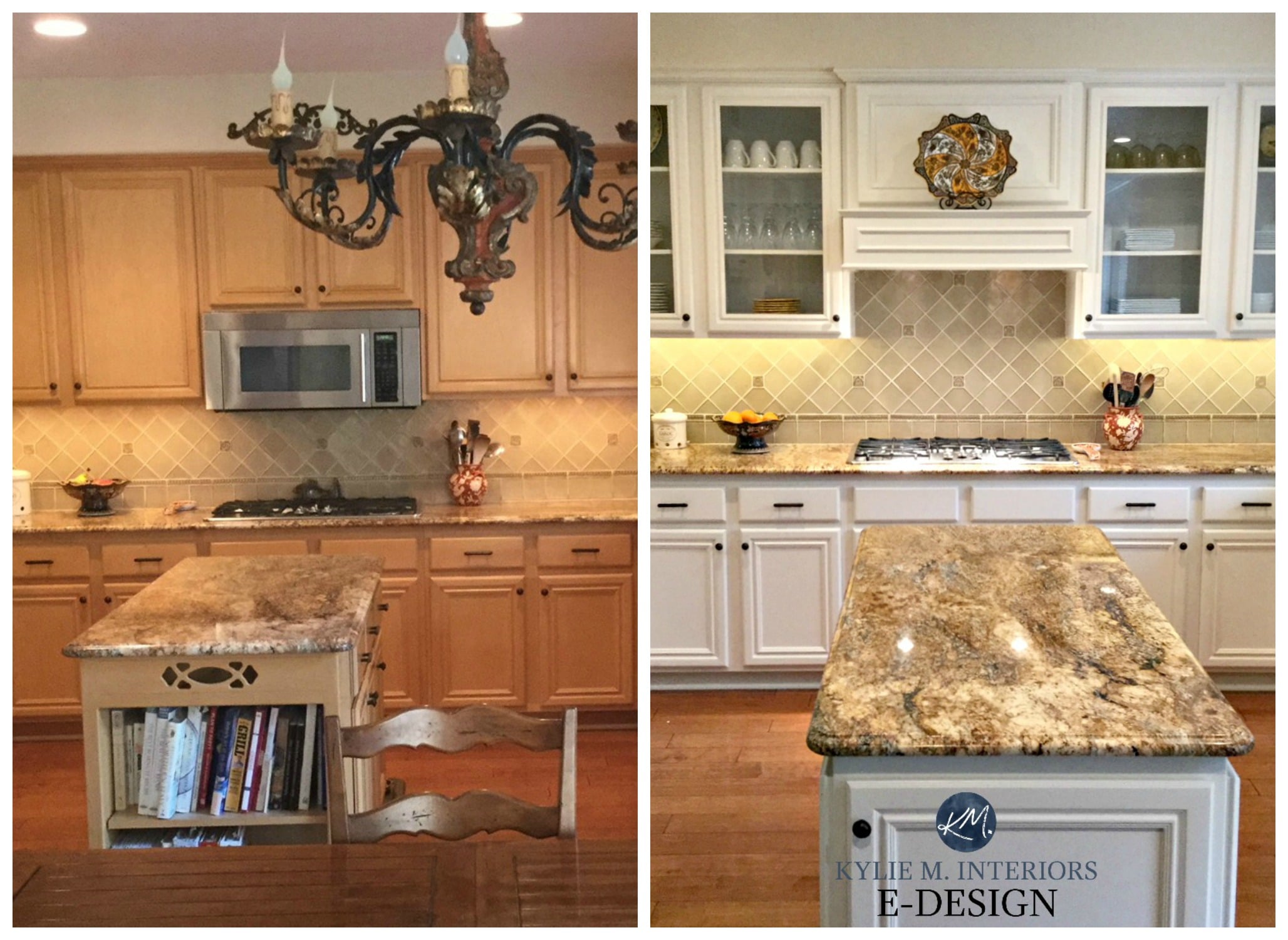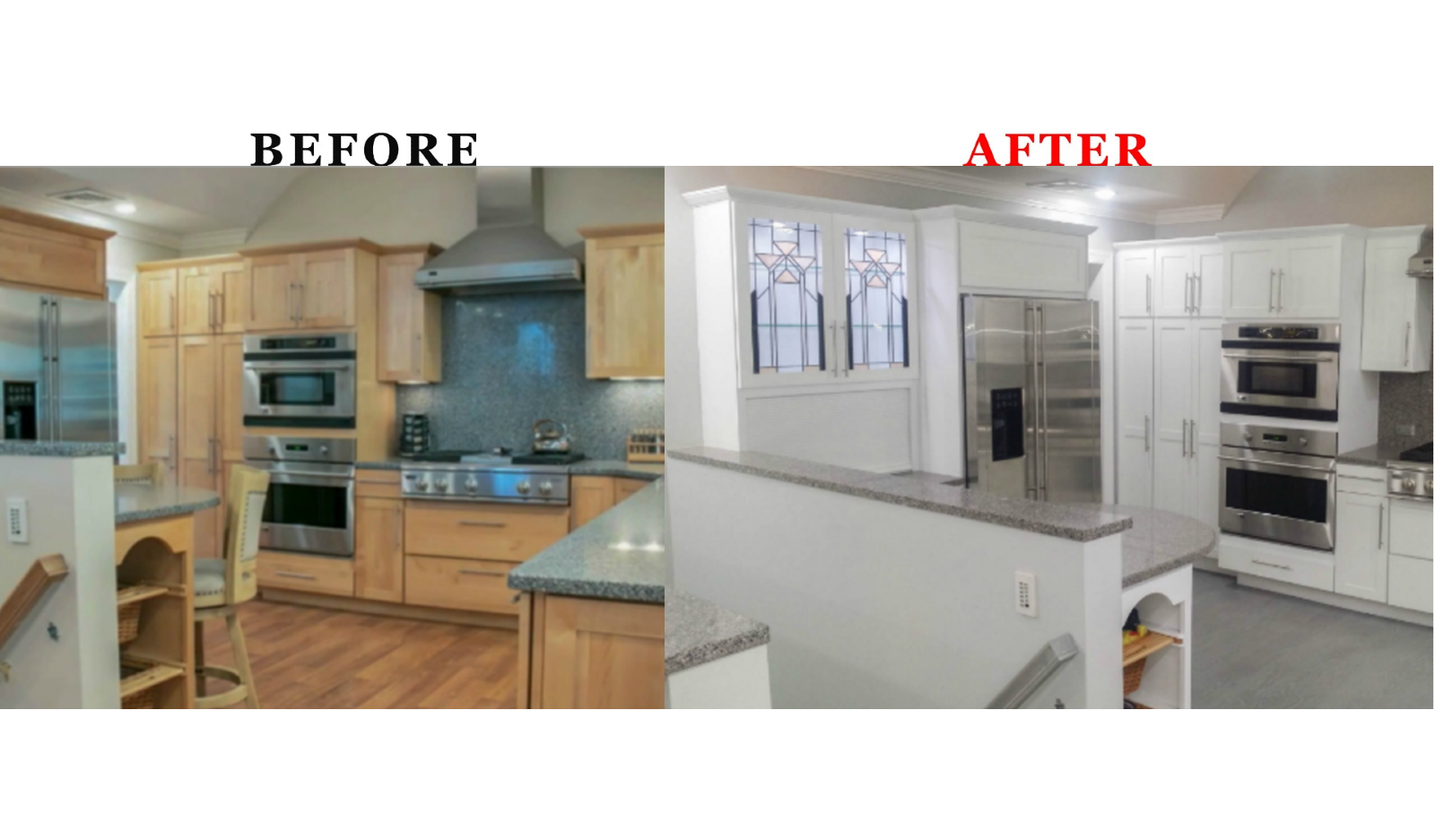Transformative Power of White Paint on Cabinets: Painting Cabinets White Before And After

Yo, painting your kitchen cabinets white is like, the ultimate kitchen makeover hack. It’s seriously transformative, taking your space from drab to fab, regardless of your current cabinet style. We’re talking a total aesthetic upgrade, and it’s way easier than you think.
White Paint’s Visual Impact on Kitchen Aesthetics
Painting cabinets white instantly brightens and opens up a kitchen. Think about it: dark cabinets can make a space feel smaller and darker, especially in kitchens with limited natural light. White, on the other hand, reflects light, creating a sense of spaciousness and airiness. For example, imagine a kitchen with dated, dark oak cabinets. After a fresh coat of white paint, the kitchen feels instantly modern and clean. Conversely, a kitchen with already sleek, modern cabinets might get an even more polished look with a crisp white finish. A farmhouse style kitchen with dark wood cabinets could transition to a bright and airy space with white painted cabinets, adding a touch of modern minimalism.
White Cabinets in Different Lighting Conditions
The magic of white cabinets really shines (pun intended!) depending on the lighting. In natural light, white cabinets look bright, clean, and almost glowy. The light reflects off the surface, making the kitchen feel open and inviting. Think of a sun-drenched kitchen – the white cabinets become almost ethereal. But under artificial light, white cabinets can still look amazing, although the perception might shift slightly. Warmer artificial lighting can give the cabinets a creamy, softer look, while cooler lighting can make them appear more stark and modern. The warmth of the light directly impacts the perceived temperature and ambiance of the kitchen. For example, warm-toned LED lighting might make white cabinets appear slightly yellowish, creating a cozy feel, whereas cool-toned fluorescent lighting might make them appear sharper and cooler.
Preparing Cabinets for Painting: A Step-by-Step Guide, Painting cabinets white before and after
Before you unleash your inner artist, prepping your cabinets is key to a flawless finish. This isn’t some quick spray-and-pray situation; we’re talking about a long-lasting, pro-level paint job. Follow these steps and you’ll be chilling in your fresh, white kitchen in no time.
| Preparation Step | Tools Needed | Procedure | Tips |
|---|---|---|---|
| Cleaning | TSP (trisodium phosphate), rags, warm water, scraper | Mix TSP according to package directions. Scrub cabinets thoroughly to remove grease, grime, and old wax. Rinse well and let dry completely. Use a scraper for stubborn residue. | Wear gloves! TSP is powerful stuff. |
| Sanding | Sandpaper (various grits), sanding block, tack cloth | Start with coarser grit sandpaper (like 120-grit) to smooth out any imperfections. Finish with finer grit (like 220-grit) for a super-smooth surface. Use a sanding block for even pressure. Wipe away dust with a tack cloth. | Don’t over-sand! You just want to create a slightly rough surface for the primer to adhere to. |
| Priming | Primer (specifically designed for cabinets), paint roller, paintbrush | Apply a thin, even coat of primer. Let it dry completely according to the manufacturer’s instructions before painting. | Use a high-quality primer designed for adhesion to cabinets. This step is crucial for a long-lasting paint job. |
Exploring Different Shades of White for Cabinets

Yo, so you’re thinking about painting your cabinets white, right? That’s totally rad. But hold up, “white” isn’t just one thing. There’s a whole spectrum of shades, each bringing a different vibe to your kitchen. Choosing the right one is key to nailing the look you’re going for.
Picking the perfect white paint for your cabinets is like choosing the perfect song for your playlist – it sets the mood. Subtle differences in undertones can dramatically change how your kitchen feels, from bright and airy to cozy and rustic. Think of it as adding the finishing touch to your kitchen’s personality. Let’s dive into the shades and see how they can totally transform your space.
White Paint Shade Variations and Their Effects
Different whites have different undertones – some lean yellow, others gray, or even a hint of pink. These undertones dramatically affect the overall feel of the room. A bright white, for instance, feels super modern and clean, while a creamy white might give off a more traditional, warm vibe. An off-white, with its subtle gray undertones, can create a sophisticated, slightly more muted look. The lighting in your kitchen also plays a huge role in how the white appears.
Examples of Kitchen Designs with Different White Cabinet Shades
Here are some examples of how different shades of white can completely change the look of a kitchen. The right shade can make all the difference!
- Bright White: Think crisp, clean, and modern. This shade works perfectly in minimalist kitchens with sleek stainless steel appliances and light-colored countertops. It creates a bright and airy atmosphere, perfect for small kitchens.
- Off-White (with Gray Undertones): This shade offers a sophisticated and slightly more subdued feel. It pairs well with darker countertops and metallic accents, creating a chic and elegant kitchen. It’s a great choice for a more transitional style.
- Creamy White: This warmer white brings a cozy and inviting feel to the kitchen. It works well in rustic or traditional kitchens, paired with natural wood elements and warmer-toned countertops. It creates a sense of warmth and comfort.
Kitchen Mood Board Designs Featuring White Cabinets
Now, let’s get visual. Here are three totally different kitchen mood boards, each showcasing a different white and its complementary color scheme.
- Modern Minimalist Kitchen: Imagine bright white cabinets paired with a stark white countertop and sleek, stainless steel appliances. The walls are a neutral light gray, and there are minimal accessories, keeping the space clean and uncluttered. The overall feel is airy, modern, and sophisticated. The bright white emphasizes the clean lines and simplicity of the design.
- Rustic Farmhouse Kitchen: Picture creamy white cabinets complemented by a butcher block countertop and open shelving. The walls are a soft, warm beige, and the flooring is a light-colored wood. The overall feel is cozy, inviting, and charming. The creamy white adds to the warm, rustic aesthetic.
- Traditional Kitchen: Envision off-white cabinets (with subtle gray undertones) paired with a classic white subway tile backsplash and dark granite countertops. The walls are a soft, creamy white, and the hardware is brushed nickel. The overall feel is elegant, timeless, and sophisticated. The off-white cabinets provide a classic and refined look, balancing the darker countertop.
Practical Considerations and Long-Term Effects
Yo, so you’ve painted your cabinets white – major upgrade, right? But let’s be real, keeping those pearly whites looking fresh isn’t just about the initial “wow” factor. It’s about the long game, the daily grind of keeping them looking snazzy. We’re talking practical stuff, the stuff that keeps your kitchen looking Insta-worthy for years to come.
Painting cabinets white looks amazing, but it’s not without its challenges. That pristine white surface is a total magnet for dirt, smudges, and – let’s be honest – the occasional kid-induced scratch. But don’t sweat it; with the right approach, you can totally rock that white cabinet look without the constant stress of upkeep.
Maintaining a White Painted Finish
Maintaining a freshly painted white cabinet finish requires a proactive approach. Think of it like this: regular maintenance is way easier than a full-blown cabinet redo. Regular cleaning is key. A simple wipe-down with a damp microfiber cloth will prevent dirt and grime from building up. For tougher messes, use a gentle cleaner specifically designed for painted surfaces – avoid harsh chemicals that could damage the finish. For scratches, a touch-up paint pen in the same shade of white is your best friend. Keep it handy for quick repairs. Consider using cabinet protectors, like clear film or bumpers, on high-traffic areas to prevent scratches and dings.
Durability Comparison: Oil-Based vs. Water-Based Paint
Choosing the right paint is crucial for long-term durability. Oil-based paints have a reputation for being super tough and durable, offering excellent resistance to scratches and moisture. They create a hard, smooth finish that’s easier to clean. However, they have a strong odor, require mineral spirits for cleanup (which is a total drag), and take longer to dry. Water-based paints, on the other hand, are low-VOC (meaning less fumes!), clean up easily with soap and water, and dry super fast. They are also more environmentally friendly. However, they might not be as durable as oil-based paints and may be more susceptible to scratches and chipping over time. The best choice depends on your priorities and the level of wear and tear your cabinets will face. For high-traffic areas, oil-based might be the way to go, but for areas with less wear and tear, water-based is a solid option.
Rewritten Article: Painting Cabinets White: A Before & After Transformation
Okay, let’s ditch the AI-generated fluff and tell this story straight up. My kitchen cabinets were, to put it mildly, seriously outdated. Think 90s oak, the kind that screamed “Grandma’s house.” They were functional, sure, but they totally killed the vibe of my modern farmhouse kitchen dreams. I decided enough was enough. I spent weeks researching, prepping, and painting. First, I carefully removed all the hardware, giving the cabinets a thorough cleaning. Then came the sanding – a seriously tedious but necessary step to ensure proper paint adhesion. I applied two coats of high-quality primer, allowing ample drying time between coats. Then came the moment of truth: painting! I opted for a semi-gloss white paint for its durability and easy-clean properties. Two coats later, my kitchen was transformed. The difference was night and day. Those drab oak cabinets were replaced by bright, crisp white ones, instantly making the kitchen feel larger, brighter, and way more stylish. The whole process was hard work, but seeing the final result – that stunning before-and-after transformation – made it all totally worth it. It’s a total game-changer, peeps!
